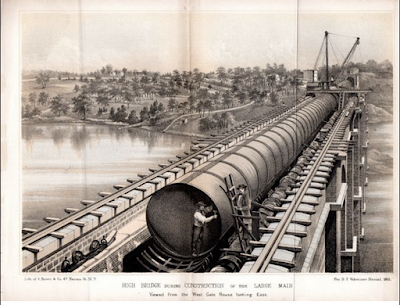In 1897 the United States Post Office started to install pneumatic tubes in a number of metropolitan areas in order to expedite the delivery of the mail. By 1898 they were in operation.
Robin Pogrebin, in an article in the New York Times on May 7, 2001, wrote an interesting article on the history of the system. In the article he highlights some of the features of the system. The system was thoroughly modern, even high-tech, a subterranean network for priority and first-class mail powered by air pressure. These tubes were installed in Boston, Philadelphia, Chicago and St. Louis. In Manhattan, they extended about 27 miles, from the old Custom House in Battery Park to Harlem and back through Times Square, Grand Central Terminal and the main post office near Pennsylvania Station. In the picture above at the at the City Hall station, the mail went over the Brooklyn Bridge to the general post office in Brooklyn.
The system used pressurized air to move a mail canister through an underground eight-inch cast-iron pipe. In New York City, two pipes were used along each route, one for sending, the other for receiving. The pipes were buried 4 to 12 feet underground, though in some places the tubes were placed within subway tunnels. Improvements in the speed of the motor-wagon and its successor, the automobile, signaled the end of the pneumatic tube. The tube system remained in operation in New York City until December 1, 1953.
 |
| Artist's impression of a Hyperloop capsule: Air Compressor on the front, passenger compartment in the middle, battery compartment at the back and air bearing skis at the bottom. |
The modern day equivalent to the pneumatic air tube of the postal service of the late 19th century might arguably be the hyperloop (see illustration above), a conceptual high-speed transportation system proposed by Elon Musk in 2013 as a means of efficiently transporting people and goods quickly over large distances. The Hyperloop would incorporate reduced pressure tubes in which pressurized capsules would ride on an air cushion driven by linear induction motors and air compressors.
We know that there are three tubes in the High Bridge. Perhaps one of those tubes, the one that was added some 40 years after the original bridge was built, when the Croton Aqueduct was expanded to meet the growing need for water in New York would be large enough to support a hyperloop vehicle.
 |
| High Bridge during Construction Tube diameter 7 ft. 6 1/2 in. |
Perhaps this could be incorporated into the mass transit system of New York City to allow residents of the Bronx to quickly cross the Harlem River to get to Manhattan. If that is not practical, then perhaps the tube might be used for some sort of tourist attraction to get visitors to come up to the northern part of Manhattan to "Ride the High Bridge Tube". After all, San Francisco has it's Cable Cars and Ferry Rides to attract tourists. New York City could become the only city in the world with a hyperloop tube!
Let us know what you think.
last modified 9/16/15

This is exactly what we need up in the park to attract more visitors. Where do these ideas come from?
ReplyDeleteWhere do you dig this stuff up?
ReplyDeleteThis is crazy, but it sure would attract people to try it out.
ReplyDelete